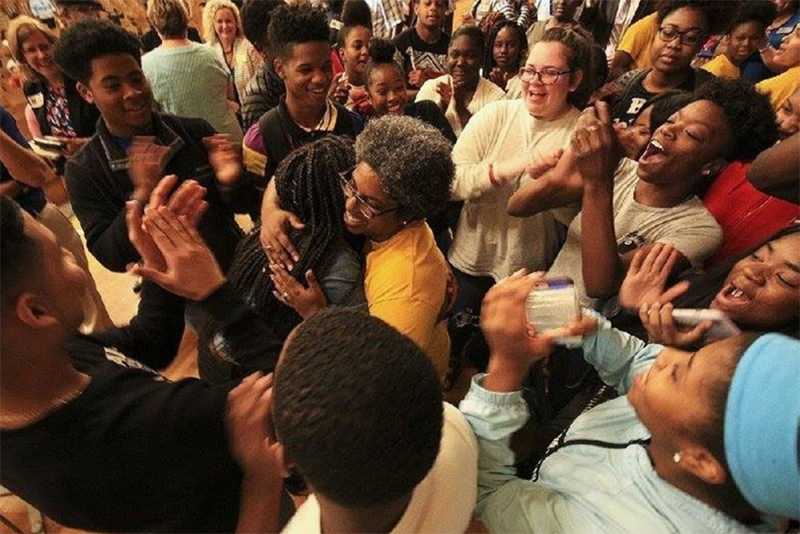
by Kalyn Belsha, Chalkbeat | Dec 12, 2019 | Headline News |
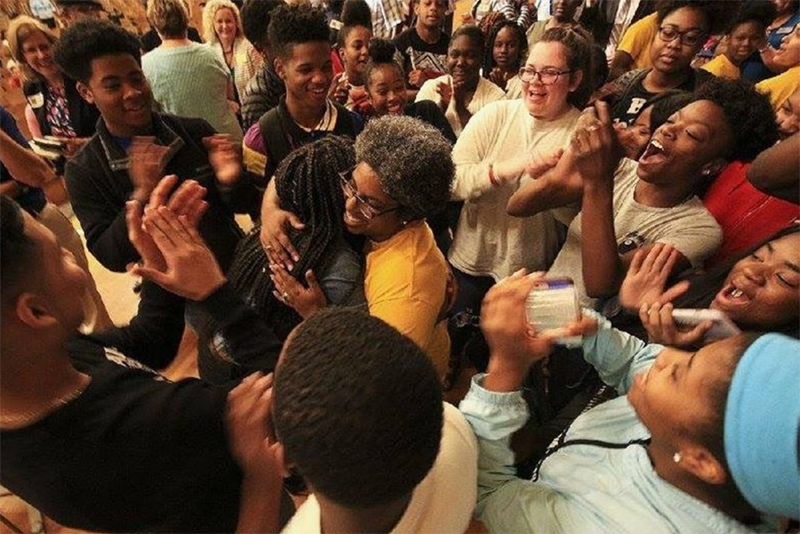
Stacey James McAdoo was named Arkansas’ 2019 Teacher of the Year. She teaches speech and AVID at Little Rock Central High School.
PHOTO CREDIT: Stacey James McAdoo
Originally posted on Chalkbeat by Kalyn Belsha on December 3, 2019
Here, in a feature we call How I Teach, we talk to educators about how they approach their jobs. You can see other pieces in the series here.
Stacey James McAdoo has deep roots in Little Rock, Arkansas. McAdoo grew up in the city, attended public schools there, and has spent 17 years working at the historic Little Rock Central High School, where she teaches speech and oversees AVID, the school’s college and career prep program.
Central High School is known nationally as the site where in 1957, a mob of white protesters and the Arkansas National Guard blocked nine black students from integrating the school, three years after the Supreme Court ruled that segregated schools were unconstitutional. Eventually, the students — who became known as the Little Rock Nine — were escorted in by federal troops.
More recently, the school was the site of another protest. In October, thousands of parents, students and teachers, including McAdoo, gathered outside Central High School to rally against a state plan that would have returned only some of Little Rock’s schools to local control — those with the highest ratings and largest enrollments of white students. Meanwhile, lower-performing schools with higher numbers of black students would have remained under state watch. Many argued the plan would have set up a two-tiered system that recalled the district’s segregated past.
McAdoo wrote a searing op-ed opposing the plan, which was later rejected, though the state board of education did strip Little Rock teachers of their collective bargaining rights. McAdoo said she wanted people to hear from someone who had a personal understanding of how the plan would affect schools.
“I am from this community, I am this community,” she said. “It was just important for me to share that, because a lot of people are making decisions about teachers without having any input from the teachers.”
As the 2019 Arkansas Teacher of the Year, McAdoo is spending this academic year touring Arkansas schools, working on statewide education issues and promoting her passion for poetry. She founded the Writeous Poets, a spoken word collective for students at her school and other youth in the community, who perform at everything from open mic nights to regional poetry slams.
We talked with McAdoo about how she gets her students to open up, how she confronts racism and other “isms” in the classroom, and how teaching in her hometown makes her a different kind of educator.
The interview has been lightly edited for length and clarity.
Was there a moment when you decided that you wanted to become a teacher?
I’ve always known that I was a teacher. When I was little, I used to line my dolls up in my bedroom and play school, and my little brother, Craig, would be my only live pupil. As he got older, school wasn’t as easy for him as it was for me. So I often found myself re-teaching him content in ways that I thought would make it easier for him. And what that looked like at that time was turning everything into a game or song to help make it more accessible.
Even though I knew that I enjoyed doing that, whenever people would ask me what I wanted to be when I grew up, I quickly learned that certain professions were more highly esteemed. So I would almost always tell people I wanted to be a pediatrician. Then you’d see everybody’s eyes light up. That was the closest thing that I could think of that would give me a career that would allow me to work directly with young people, and that would give me the money that I thought I needed in order to be deemed successful.
Fast forward to 17 years ago, my brother died in a car accident, and it crushed me. At that moment, I realized that life was too short not to do what I thought that I was meant to do. So I quit my secretary job, and enrolled in a non-traditional teaching certification program.
What was your biggest misconception that you initially brought to teaching?
When I first told people that I was going to go into teaching, people thought I had really gone mad. They were saying stuff like, “The kids are bigger than you, they’re bad, they don’t want to learn.” And I don’t know that that was necessarily my misconception, but that is a misconception, particularly of urban youth. They think they’re these hardcore kids — they don’t even see them as kids — who don’t care about anything and don’t want to learn. I honestly have never encountered a student who either did not care about something or a kid who was not interested in learning about anything.
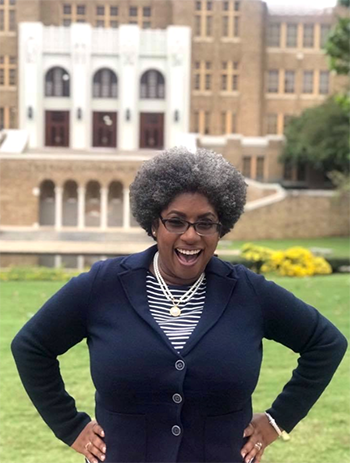
Teacher Stacey James McAdoo pictured outside Little Rock Central High School, where she’s taught for 17 years.PHOTO CREDIT: Stacey James McAdoo
You grew up in Little Rock and attended public schools there. How do you think that impacts you as an educator?
Because I am from this community, and have never left this community, I’m still very connected. My roots run really deep and my reach is very wide. I tell students all the time that if they give me a few minutes, I’m almost certain I can find somebody that the two of us know in common.
Also, I live in the neighborhood with the students, they see me at church, they see me at the grocery store. I encounter the students all the time. It helps in a lot of different ways. It helps me with discipline; it helps me with establishing street cred. It definitely deepens our relationship.
What’s something happening in the community that affects what goes on inside your classroom?
Everything that goes on in the community affects what happens in my classroom. That’s everything from jobs to whether or not there are grocery stores that get closed in our neighborhood. At Central High School, there are almost 2,500 students. We are, for all practical purposes, a small town. Students don’t just come to school and forget or wipe clean everything that they experienced or saw the night before. They bring all of that with them to the classroom, and if we ignore it and just expect them to come in and solely be about their academics, and not anything else, then I think we’re not seeing them as humans.
Do you have any special techniques that you use to try to get to know your students?
We do a lot of talking and sharing. Every day, the students have some type of journal that they’re writing. I pretty much use the journals as a dialogue between me and the students. We sing in class every day. I do logic questions and riddles to get them thinking, and we do a check-in on what have you been up to since the last time I’ve seen you, and/or a recap of what we learned last class period, and then we go into whatever we’re doing. Building community is a staple in the classroom.
I cannot teach a child that I don’t know. And I think that relationships are the key. Once a student, in my opinion, feels seen, and heard, and valued, you pretty much have them, and they’ll do anything that you ask them to do, and they will almost always exceed any expectation that you place before them.
Do you have a favorite lesson to teach? If so, can you tell me where the idea for it came from?
My favorite lesson is a unit that I call the “isms” unit. We go in-depth where we learn about different stereotypes and all of the different “isms.” I’m sure you’re familiar with Jane Elliott’s blue eyes, brown eyes experiment? She was an elementary teacher. One day she played favorites with the kids. Kids who had blue eyes were the ones that were the smartest. That definitely is what sparked the whole idea for this particular unit.
On the first day, the journal prompt is to pretend that they are the opposite gender and a different race. And they are supposed to write about the benefits of their newfound identity. By this point, they know that whatever they write is going to be considered safe.
This usually coincides around September, which for us is when the Little Rock Nine desegregated Central High School, so that’s when students at Central begin to be reminded of the history. So you would think that they would sort of have an idea of where I’m going with this, but they don’t. We do a visit over to the Little Rock Central High museum. Then they come to class one day, and there are these columns that are written on the board. I’ve gone through all of the journals and every derogatory comment that I discovered in there, I write it on the board under whatever that category is. It has some light stuff, but then they also get really ugly. They’ll say stuff like, if it’s a white student who suddenly became African-American, now they get to benefit from affirmative action and can go to college for free.
I have also divided the class: Males are sitting up front, females are sitting in back. I have a black section, I have a white section, and I have a section for people who don’t identify as black or white. When they walk into the classroom, I tell them there’s no talking today. You walk straight in this classroom, read the sign, and sit where you’re supposed to sit. The students pretty much fall in line. You’ll see them getting upset. After the bell rings and everybody’s in there, I go through all the categories, but I only allow people that are in that category to speak on how the things written about them made them feel. And they can only say, “When I heard this, I felt like…” And that’s how that dialogue goes.
Once we go through all of that, there are signs that are also posted along my classroom that will illustrate all of the different “isms” that are out there. The students are required to stand under the sign that they would least like to be. Then we have a discussion and talk in small groups. I tell the students: Just like you would not want to be in this category, people who suffer from oppression or any of the “isms,” they don’t necessarily choose to be whoever they are, or to be in that station of life. And so we need to think more critically and carefully about how we view people and what we say to people.
There are lots of “aha” moments. During that particular day when they’re physically separated… they’re crying, they’re apologizing to each other.
That next class is where they actually do a presentation on one of the “isms.” It is always about civil rights in this century and what a teenager can do to end the injustices.
What part of your job is the most difficult?
Today. [McAdoo received a phone call earlier in the day that a former student had died in a car crash.] The hardest part about teaching is knowing that your students, their families, are dealing with a lot of painful things that you may not be able to fix. Having a student die is always hard, but it doesn’t have to be a death. I’ve had students that I’ve had to go visit in hospitals because they were committed for various illnesses, or they tried to harm themselves. I’ve been called to the hospital by the chaplain when a parent of a student died and the student didn’t have anybody else to call. I’ve been called to a parent’s house to literally help get a student out of the closet, because the student was suffering from a breakdown. I’ve been called by a parent to help them go find a child that ran away.
The most difficult part is the things that happen in society and how it impacts our students. And not even just the students, teachers too. They bring it to school, and it manifests in different ways. Some of them are able to cope. But a lot of them don’t quite have the strategies to help them process or deal with all of the trauma that they encounter.
I like to check up on the kids, I don’t want them to think that just because they leave my classroom or they leave my presence — I need them to know that they still have my love and my support. We are very, very much connected.
What from your classroom would you be helpless without during the school day?
My students. If they didn’t show up and show out, in a good way, every day, then I wouldn’t have a purpose. I’m extremely thankful and grateful that they trust me, and that they allow me, not just into their lives, but into their hearts. They are the reason, for everything.
Chalkbeat is a nonprofit news site covering educational change in public schools.
); ?>)
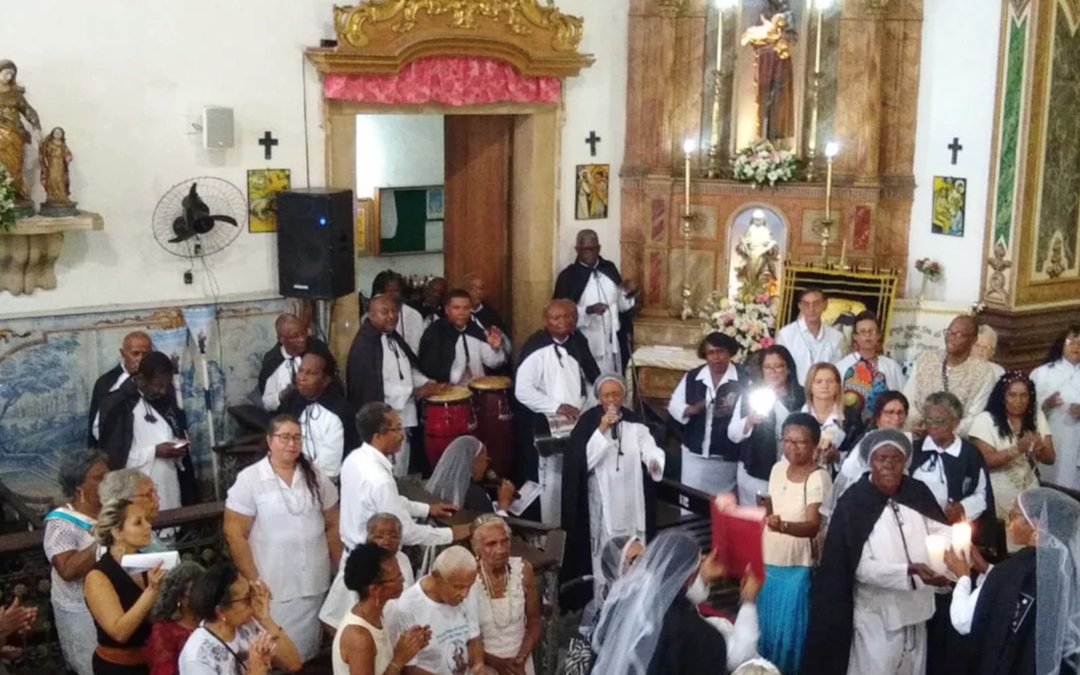
by Eduardo Campos Lima, RNS | Dec 12, 2019 | Headline News |
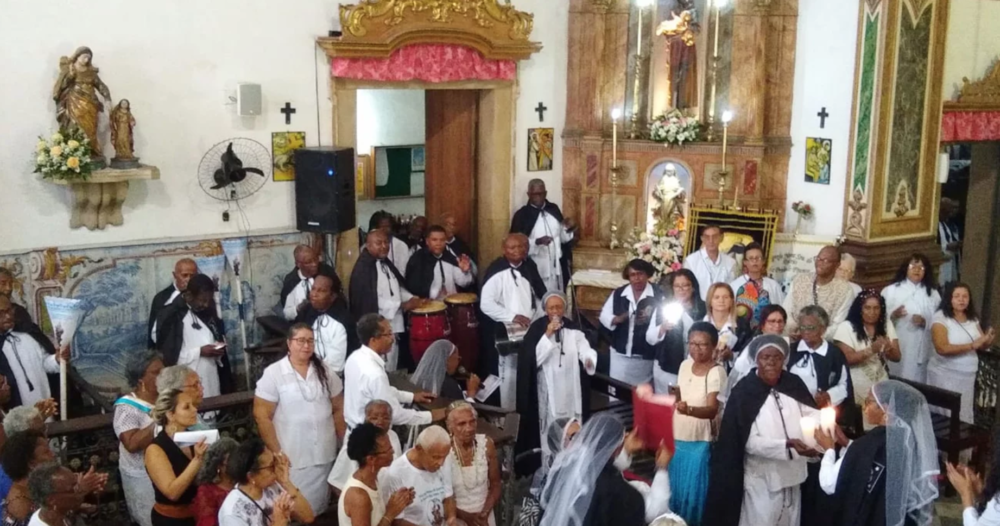
Members of black brotherhoods participate in a service at the Church of Our Lady of the Rosary of the Black Men in Salvador, Brazil. Courtesy photo by William Justo
At the end of October, members of Brazil’s Catholic black lay associations gathered in the northern port city of Salvador to discuss their centuries-long history and the challenges facing the new network they have formed — an association of associations — in a country where the Catholic Church itself is questioning its future.
Created by slaves and emancipated black men and women in colonial times, when they were not allowed to attend the same churches as their white masters, the black lay associations were once refuges of solidarity and resistance against slavery. Most made efforts to buy freedom for their enslaved members. “Our brotherhood functioned as an important center in the abolitionist struggle,” said Antônio Nicanor, a member of the Brotherhood of the Black Men in Salvador.
But the existence of the black Catholic groups is threatened by the same societal forces that are draining all established religions of members and energy, chiefly the loss of young people. “The average age in our brotherhood is 55,” Nicanor told Religion News Service. “In most of the organizations all over Brazil, there’s no effective renewal.
“Since 2017 we’ve been working to reunite all brotherhoods and communities in Brazil, in an effort to grow stronger,” said Nicanor, referring to the network that is meant to bolster brotherhoods like his. “Our organizations are aging, and we have to fight against their end.”
Some of the decline has to do with problems particular to Brazil’s complex religious landscape. The lay associations have long been concerned with the conservation of African culture in the church, and many members are loyal both to Catholicism and to Afro-Brazilian religions such as Candomblé and Umbanda. These allegiances have caused some Catholic clergy to regard them with suspicion.
“We still suffer with the prejudice of some people in the Church,” said Analia Santana, a member of Nicanor’s Brotherhood of the Black Men and an academic researcher specializing in its history.
“Many priests say they don’t know anything about the black brotherhoods. Seminaries don’t talk about us. What happens if a priest like this is suddenly appointed as our chaplain?” asked Vanilda Silvério, vice-director of the Brotherhood Our Lady of the Rosary of the Black Men, in São Paulo.
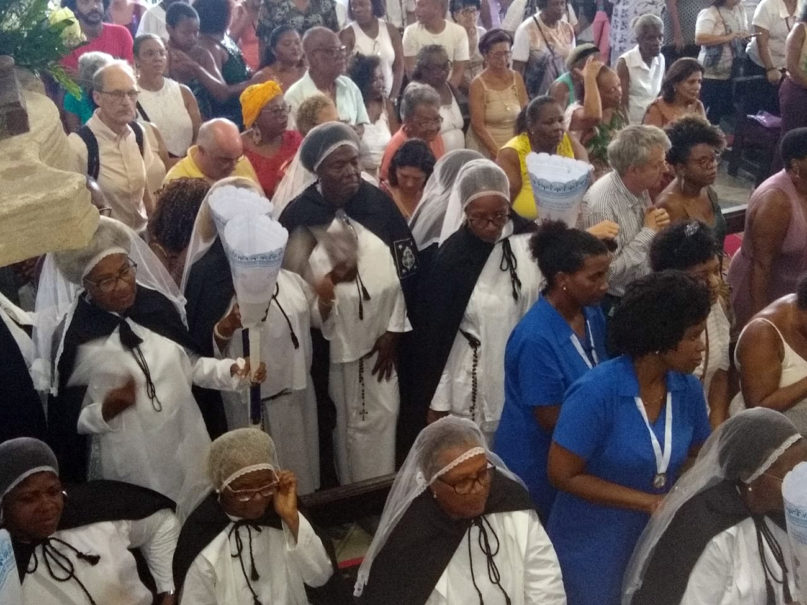
Members of black brotherhoods, which include both men and women, attend a service at the Church of Our Lady of the Rosary of the Black Men in Salvador, Brazil. Courtesy photo by William Justo
(In Portuguese, the term for these communities, “irmandade,” encompasses both men and women, though it is often rendered as “brotherhood” in English, and many specify black men in their titles. Even so, women such as Silvério have only served in leadership roles since the early 2000s.)
Her association has existed in São Paulo since 1711 and counted more than 400 members a few decades ago. Now there are 62 brothers and sisters. “My grandfather joined the brotherhood in the 1920s. Now one of my daughters is also a member,” said Silvério.
Her younger daughter, however, resists the idea of taking part in the group. “I’m 57. I’m worried about the future. I don’t see many young people joining the brotherhood. They don’t have time to contribute — they have to study and work.”
Like many shrinking institutions, Brazil’s lay Catholic associations both benefit from an infrastructure built up during their high times and pay dearly to maintain it. Most of the black fraternities own their churches, cemeteries and other historical buildings and are responsible for their conservation.
They also manage investment funds set aside for these properties’ preservation, for association activities and to pay a few employees, but the members generally lack the financial expertise to do so, according to the Rev. Lázaro Muniz, who was chaplain of the Brotherhood of the Black Men for seven years until early 2019.
During his tenure, Muniz created an archdiocesan commission in Salvador in order to keep up with the brotherhoods’ activities. “They’re independent entities, but we struggled to help them reform their bylaws and make several changes for their own good. Several fraternities had to close due to management problems. Our struggle is to preserve them,” he explained.
He was also one of the proponents of the national network of black Catholic lay associations founded three years ago.
“We hope very much this network will strengthen the brotherhoods. The meetings were very successful, and many of them are already in the process of reorganization,” he said. He added that they are forging bonds with the Afro-Brazilian pastoral commissions in their dioceses that deal with black churchgoers.
Over 500 years, the lay associations have weathered changes in the Church and the larger culture. Nicanor’s Brotherhood of the Black Men, probably the oldest black brotherhood still active in Brazil, shows up in official records in 1685, but there’s evidence it was created in 1604, according to Santana. Their staying power gives current members hope.
“Our brotherhood was always able to dialogue with the changing times and to renew itself. Many other entities had to close their doors throughout the centuries,” Santana explained.
They also have the advantage of being deeply rooted in the lives of rural communities. Though many brotherhoods originated in Salvador, Brazil’s first capital city and still its premier archdiocese, they soon spread across the country. They have long organized annual festivities in honor of their saints of devotion — black saints like Saint Benedict the Moor, Saint Elesbaan, Saint Ephigenia of Ethiopia and Saint Anthony of Carthage, who incorporated elements of the residents’ original African cultures.
These highly ritualized festivities, known as congadas, included the coronation of a king and a queen of the brotherhood. Although many of the urban fraternities don’t organize congadas anymore, they still can be seen in the countryside.
It is this kind of local religious culture that got favorable attention at the recent Synod for the Pan-Amazon Region, where Pope Francis urged bishops to reflect on “enculturation,” as the Church calls adaptation of Christianity to local contexts. Muniz believes this kind of thinking may be helpful in renovation of the Brazilian brotherhoods.
“This moment invites the fraternities to search for news ways, assuming a path of evangelization and offering possibilities for the youth to assume their traditions.”
For Nicanor, the black lay associations still have a contribution to make for a church that, guided by Francis, is looking for more lay involvement. “The church needs to feel that it’s the lay people who make Catholicism and not the clergy,” he said.
At the end of October, members of Brazil’s Catholic black lay associations gathered in the northern port city of Salvador to discuss their centuries-long history and the challenges facing the new network they have formed — an association of associations — in a country where the Catholic Church itself is questioning its future.
Created by slaves and emancipated black men and women in colonial times, when they were not allowed to attend the same churches as their white masters, the black lay associations were once refuges of solidarity and resistance against slavery. Most made efforts to buy freedom for their enslaved members. “Our brotherhood functioned as an important center in the abolitionist struggle,” said Antônio Nicanor, a member of the Brotherhood of the Black Men in Salvador.
But the existence of the black Catholic groups is threatened by the same societal forces that are draining all established religions of members and energy, chiefly the loss of young people. “The average age in our brotherhood is 55,” Nicanor told Religion News Service. “In most of the organizations all over Brazil, there’s no effective renewal.
“Since 2017 we’ve been working to reunite all brotherhoods and communities in Brazil, in an effort to grow stronger,” said Nicanor, referring to the network that is meant to bolster brotherhoods like his. “Our organizations are aging, and we have to fight against their end.”
Some of the decline has to do with problems particular to Brazil’s complex religious landscape. The lay associations have long been concerned with the conservation of African culture in the church, and many members are loyal both to Catholicism and to Afro-Brazilian religions such as Candomblé and Umbanda. These allegiances have caused some Catholic clergy to regard them with suspicion.
“We still suffer with the prejudice of some people in the Church,” said Analia Santana, a member of Nicanor’s Brotherhood of the Black Men and an academic researcher specializing in its history.
“Many priests say they don’t know anything about the black brotherhoods. Seminaries don’t talk about us. What happens if a priest like this is suddenly appointed as our chaplain?” asked Vanilda Silvério, vice-director of the Brotherhood Our Lady of the Rosary of the Black Men, in São Paulo.

Members of black brotherhoods, which include both men and women, attend a service at the Church of Our Lady of the Rosary of the Black Men in Salvador, Brazil. Courtesy photo by William Justo
(In Portuguese, the term for these communities, “irmandade,” encompasses both men and women, though it is often rendered as “brotherhood” in English, and many specify black men in their titles. Even so, women such as Silvério have only served in leadership roles since the early 2000s.)
Her association has existed in São Paulo since 1711 and counted more than 400 members a few decades ago. Now there are 62 brothers and sisters. “My grandfather joined the brotherhood in the 1920s. Now one of my daughters is also a member,” said Silvério.
Her younger daughter, however, resists the idea of taking part in the group. “I’m 57. I’m worried about the future. I don’t see many young people joining the brotherhood. They don’t have time to contribute — they have to study and work.”
Like many shrinking institutions, Brazil’s lay Catholic associations both benefit from an infrastructure built up during their high times and pay dearly to maintain it. Most of the black fraternities own their churches, cemeteries and other historical buildings and are responsible for their conservation.
They also manage investment funds set aside for these properties’ preservation, for association activities and to pay a few employees, but the members generally lack the financial expertise to do so, according to the Rev. Lázaro Muniz, who was chaplain of the Brotherhood of the Black Men for seven years until early 2019.
During his tenure, Muniz created an archdiocesan commission in Salvador in order to keep up with the brotherhoods’ activities. “They’re independent entities, but we struggled to help them reform their bylaws and make several changes for their own good. Several fraternities had to close due to management problems. Our struggle is to preserve them,” he explained.
He was also one of the proponents of the national network of black Catholic lay associations founded three years ago.
“We hope very much this network will strengthen the brotherhoods. The meetings were very successful, and many of them are already in the process of reorganization,” he said. He added that they are forging bonds with the Afro-Brazilian pastoral commissions in their dioceses that deal with black churchgoers.
Over 500 years, the lay associations have weathered changes in the Church and the larger culture. Nicanor’s Brotherhood of the Black Men, probably the oldest black brotherhood still active in Brazil, shows up in official records in 1685, but there’s evidence it was created in 1604, according to Santana. Their staying power gives current members hope.
“Our brotherhood was always able to dialogue with the changing times and to renew itself. Many other entities had to close their doors throughout the centuries,” Santana explained.
They also have the advantage of being deeply rooted in the lives of rural communities. Though many brotherhoods originated in Salvador, Brazil’s first capital city and still its premier archdiocese, they soon spread across the country. They have long organized annual festivities in honor of their saints of devotion — black saints like Saint Benedict the Moor, Saint Elesbaan, Saint Ephigenia of Ethiopia and Saint Anthony of Carthage, who incorporated elements of the residents’ original African cultures.
These highly ritualized festivities, known as congadas, included the coronation of a king and a queen of the brotherhood. Although many of the urban fraternities don’t organize congadas anymore, they still can be seen in the countryside.
It is this kind of local religious culture that got favorable attention at the recent Synod for the Pan-Amazon Region, where Pope Francis urged bishops to reflect on “enculturation,” as the Church calls adaptation of Christianity to local contexts. Muniz believes this kind of thinking may be helpful in renovation of the Brazilian brotherhoods.
“This moment invites the fraternities to search for news ways, assuming a path of evangelization and offering possibilities for the youth to assume their traditions.”
For Nicanor, the black lay associations still have a contribution to make for a church that, guided by Francis, is looking for more lay involvement. “The church needs to feel that it’s the lay people who make Catholicism and not the clergy,” he said.






